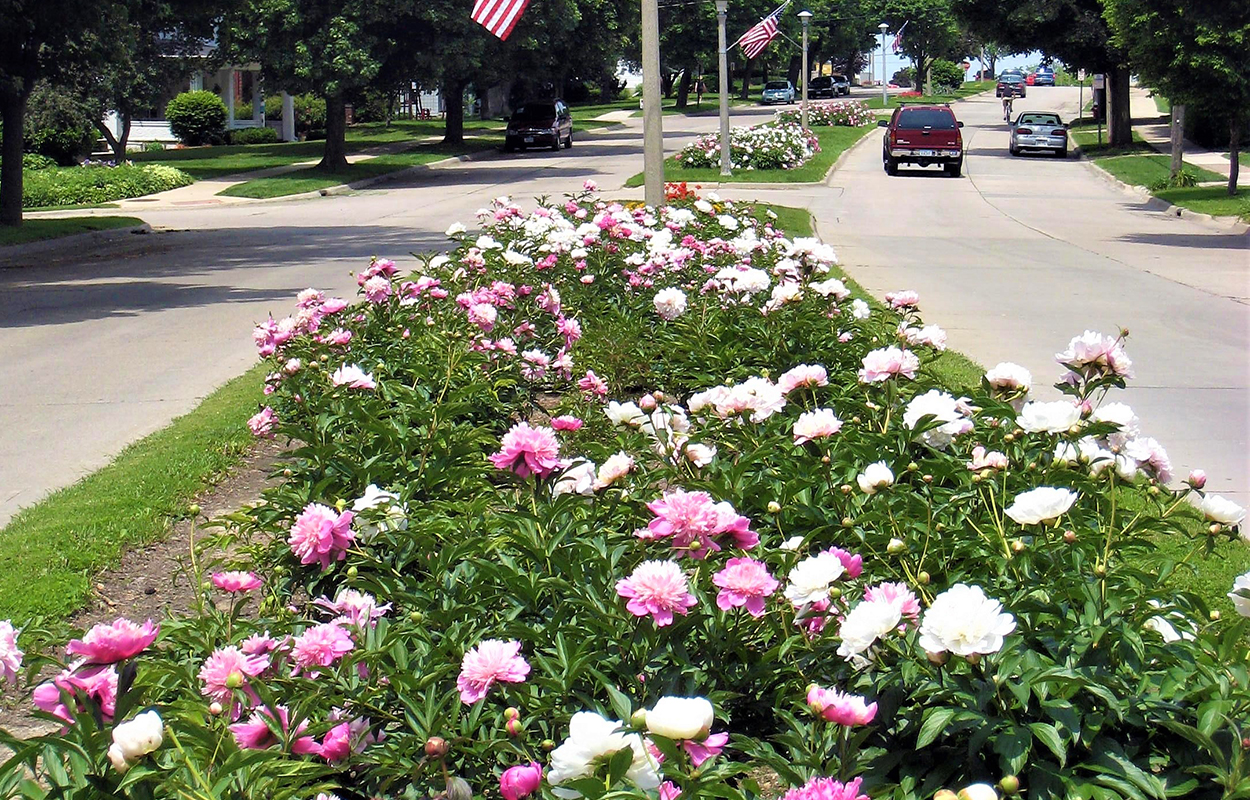In May, peonies throughout the Midwest begin to burst into big, showy blooms – a riot of red, pink, and white. One of the best places to admire peonies in Dubuque is along Grandview Ave. – a remnant of the city’s historic “Peony Trail.”
The Peony Trail dates back to the late 1930s. Edwin B. Lyons served as the first president of Dubuque Civic Garden Club, an organization set up in 1935 to “stimulate the knowledge and love of gardening among amateurs; aid in the protection of native trees, plants, and birds; and to encourage civic planting and beautification in the community.” Although Edwin was president of the Garden Club, it was his wife Ella who came up with the idea of a trail of peonies winding across the city.
The Garden Club agreed with Ella, and in late summer 1938, approved the Peony Trail project with just $40 in its treasury. By the end of the year, the club had collected 5,000 peonies without dipping into the treasury. With the plants in hand, the Peony Trail route was mapped out.
The first peony was planted in late September 1938 in Washington Park, the starting point of the Trail. Ella shoveled dirt while Wendelin Rettenberger, Dubuque superintendent of parks, did the planting.
Ella urged gardeners to plant more peonies in a September 3, 1939, Telegraph Herald article:
“Nothing gives more beauty with less care through the years than peonies. Anyone who plans to make his surroundings more attractive and lovely, thereby adding considerable to the beauty of the city, will do well to make plans to include peonies … Anyone having old clumps which need dividing will confer a favor if they will get in touch with a member of the Garden Club and turn the surplus over to them for use in this year’s plans. Much was accomplished last year … and the Civic Garden Club is asking help again in order that the Peony Project may be completed. About four thousand plants will be needed.”
Ten thousand peonies had been planted by 1940. When Ella died in November 1940, Edwin took over the Peony Trail project. A bronze plaque memorializing Ella was placed in Washington Park and dedicated in a ceremony on May 27, 1941. Washington Park was renovated in the late 1970s, and the plaque was moved to the peony beds along Grandview Ave.
The Peony Trail continued to grow in popularity. Local flower enthusiasts and visitors needed help following the fifteen-mile route that wound through Dubuque from Washington Park to Eagle Point Park. The Garden Club purchased cast iron markers, designed with an arrow and a pink peony blossom to designate the route of the Trail. Dubuque park employees installed the markers in parks and along streets. Later, markers identifying names of peony plants were placed in flowerbeds.
In a May 25, 1941 article, the Telegraph Herald printed directions for those wanting to follow the Peony Trail. Starting at Washington Park on Locust St., the Trail turned west up 6th St. to Bluff and south to the elevator on Fourth St. The Trail continued to 2nd St., passing St. Raphael’s Cathedral, and returned to Locust. From Locust, the Trail headed up Southern Ave. to Grandview (now Murphy) Park.
After circling the park, the Trail went south to Mt. Carmel. Doubling back along Grandview to Bryant, the Trail traveled down Rush to Villa and then to Cleveland Park. Returning to Grandview and on to Delhi, the Trail ran past the University of Dubuque, along Asbury and Seminary (now Clarke Dr.) to Madison Park, and down Madison St. to Jackson Park. Finally, the Trail continued north on Jackson to Lincoln and on to Windsor, returning to Lincoln and traveling along Shiras to the end of the Trail in Eagle Point Park.
In 1957, Edwin Lyons gave the city 37 shares of American Telephone and Telegraph Company (AT&T) Common Capital Stock “for the express purpose of using the income there from to maintain and perpetuate the Dubuque Peony Trail.” Edwin died in 1970, and in 1972 his estate bequeathed $290,000 to the City of Dubuque and the Dubuque Park Board for the development of recreational and park areas in Dubuque Co. The Lyons Trust Fund was used along with matching federal funds to purchase property where the E.B. Lyons Interpretative Center now stands within the Mines of Spain Recreation Area.
In June 1983, the Lyons’ son, Edwin L., complained that Dubuque’s short-staffed park department had neglected to properly maintain the Peony Trail. Spurred by Edwin’s complaint and the discovery of extra funds in the trust, park staff trucked in 65 loads of soil to “beef up the anemic clay” and planted 2,400 replacement peonies along Grandview Ave. with the help of Youth Conservation Corps and volunteers.
Today, only portions of the original Peony Trail remain. Peonies still bloom in many locations, including Grandview Ave., Shiras Ave., Eagle Point Park, and Washington Park. The care of the Peony Trail is still partially funded through the Lyons Peony Trust.
“The Trust earnings do not fully fund all our work, care, and replacement of the peonies,” said Marie Ware, Leisure Services Manager. “The remainder of the work on the Peony Trail not covered by the earnings is funded through the Parks Division operating budget – your tax dollars at work. The work on the Trail is completed by the Parks Division of Leisure Services; horticulturalist Kelly Goosen and her staff care for this area.”
Ware concluded, “Mr. and Mrs. Lyons really did leave a gift to the community, as so many enjoy the peonies during their full bloom. The Trust and the peonies are a gift that keeps on giving each year.”
This article is part of the Shades of Dubuque series, sponsored by Trappist Caskets, hand-made and blessed by the monks at New Melleray Abbey.




Comment here